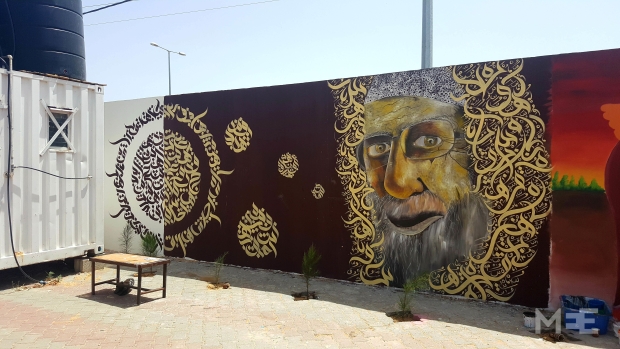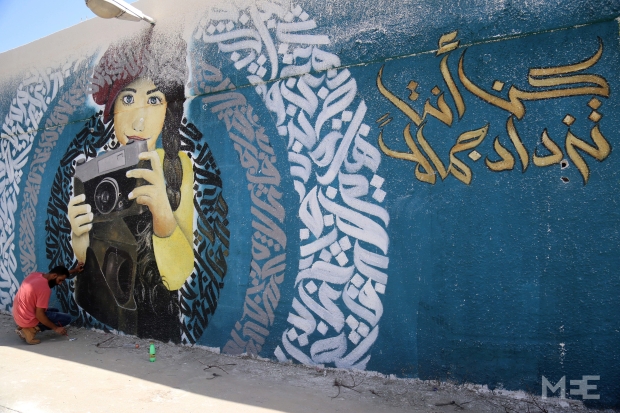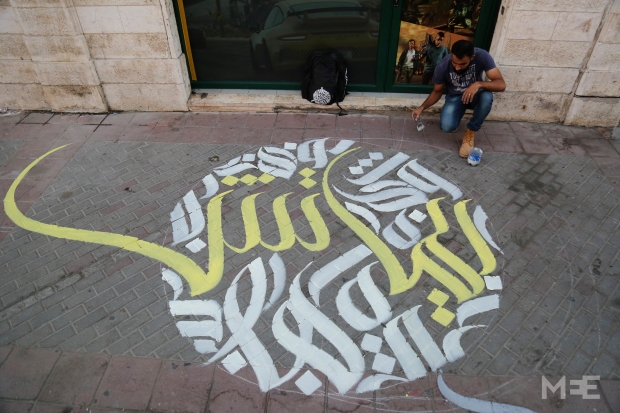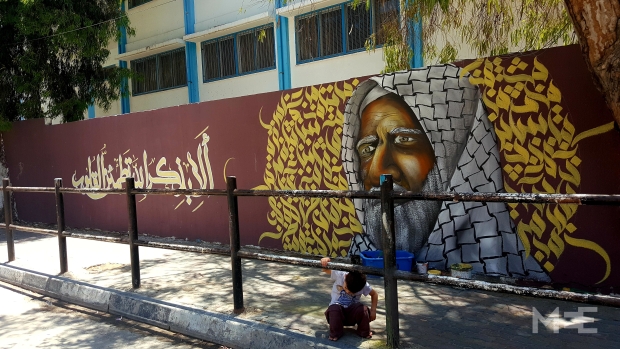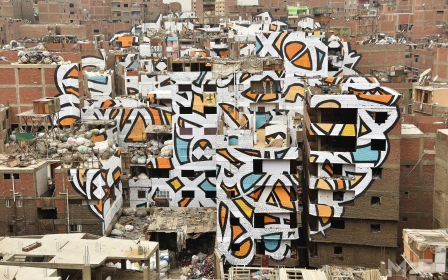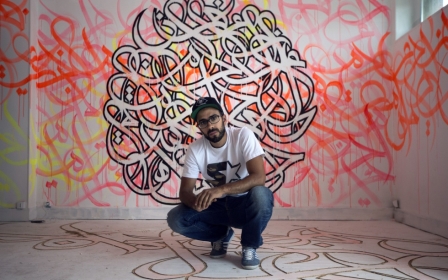Calligraffiti artist transforms the streets and alleyways of Gaza
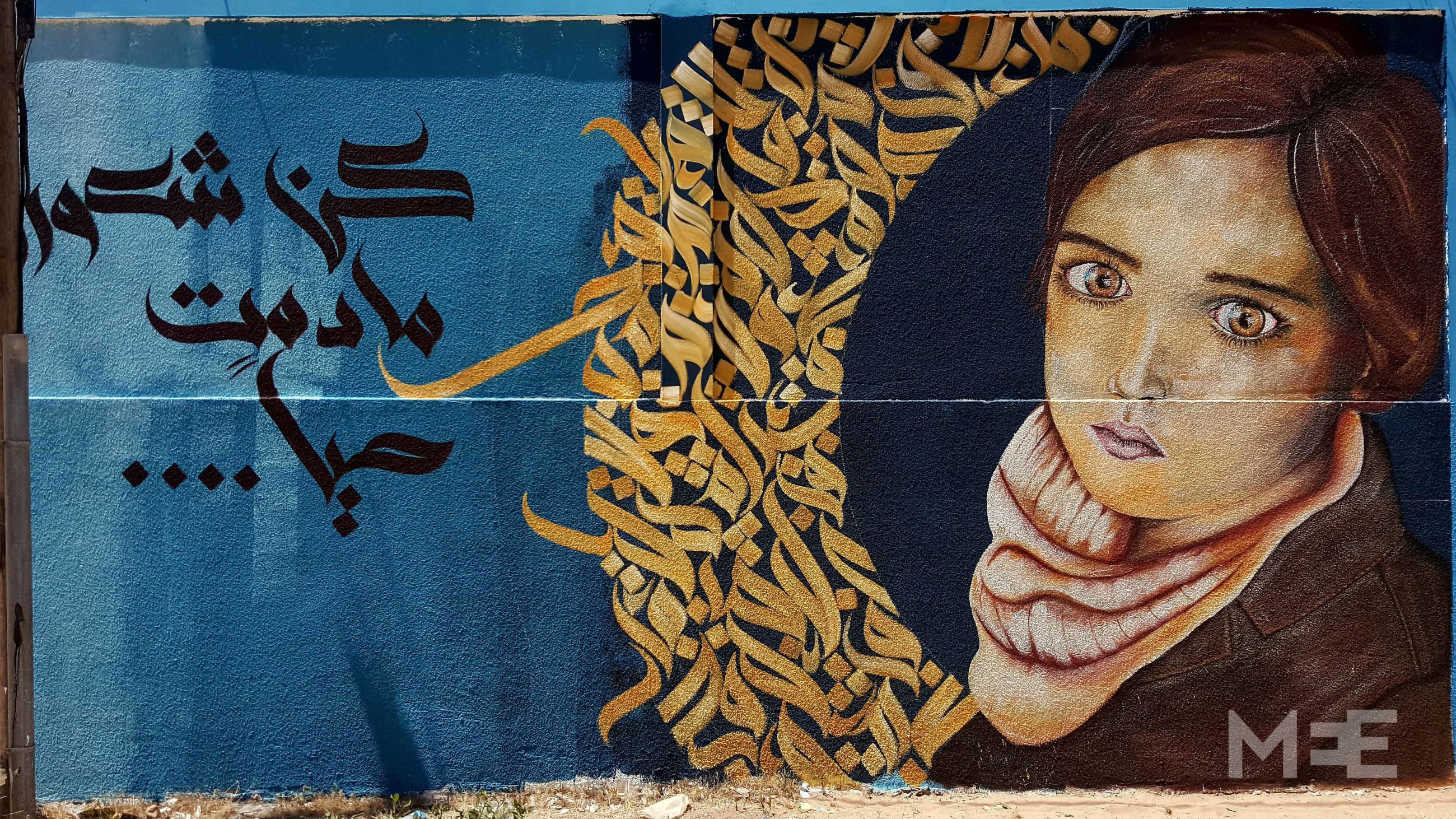
GAZA - Under the scorching sun, calligraffiti artist Yazeed al-Talaa picks up a brush with his right hand and begins to paint. Using a vigorous arcing action from side to side, his brush moves across the rough surface of a wall. Passers-by stare at him wondering what he is doing to this wall in the middle of Gaza City, but Talaa knows exactly what he is doing. Three hours later the work is complete.
By integrating the beauty of Arabic letters with the modern art of graffiti, Talaa was able to convert a very old wall into a stunning work of art.
"Calligraffiti is a fusion of calligraphy and graffiti; a growing, global art," he tells Middle East Eye, taking a break and stepping back from his latest creation.
Embracing Arabic roots
The 24-year-old Palestinian artist from al-Maghazi refugee camp studied interior design at Al-Aqsa University in Gaza.
He began his artistic journey three years ago by using English letters, but then decided to embrace the use of his mother-tongue, Arabic.
"In the beginning, it was really difficult since the Arabic language is the hardest one to use in this art form. However, I feel as though, by practising consistently, I'm beginning to master the calligraffiti style," he says.
"Eventually I began to rely totally on Arabic letters, words and sentences, often trying to convey a message that I felt needed to be delivered through the art."
The Smiling Palestinian Child painting on Gaza Street has special meaning for Talaa, since he spent a great deal of time on its creation and considers the child's smile to be more impactful than any words. He explains that the portrait embodies the innate condition of Palestinian children who smile despite their pain.
Vague portraits
On another wall of a building in Gaza, he has painted the image of a young girl holding a camera surrounded by concentric circles made up of Arabic letters. "Be yourself and your beauty will increase," the words read.
"A few people can decipher my paintings' messages by themselves but others ask me curiously to explain exactly what I mean with each one," he says.
Talaa's innovation is not limited to painting on Gaza's streets and walls, but has extended into people's homes too. Several Gazans have approached him, asking him to create his artwork in their own homes after they've become fans of his work seeing it in the street.
More often than not, he is happy to oblige. "I try to draw calligrafitti so people can see the drawings and smile in spite of the suffering we are experiencing." He is keen to show the bright side of contemporary life in Gaza, he says.
Messages and ambitions
The artist says he wants to familiarise people with the aesthetics of the Arabic language at a time when calligraphy is close to becoming a lost art.
Talaa hopes to one day have a permanent exhibition to showcase his art, so that he can teach people more about calligrafitti.
Gazans, in spite of tough living conditions and the lack of employment, are still trying to show their talents to the world in more than one field.
Sobhi Qouta, a 25-year-old Gazan who has taken part in activities organised by the Tamer Institute, says: "The evolution of art at the community level, on the one hand depends on the aesthetic side, and on the other hand can deliver messages of love and life and peace to the world, showing that Gaza is a source of beauty and artists."
He says that it is not an exaggeration to believe that Gaza will one day become a hub to showcase artistic talent and display the beautiful paintings that reflect life and peace, created through individual efforts and through community-based initiatives undertaken by the Tamer Institute and others.
The Israeli siege on the Gaza Strip for the last 10 years has been a major obstacle for Talaa - and other artists - as it prevents them from travelling abroad and participating in international exhibitions to present their special brand of Palestinian calligrafitti.
Talaa hopes to one day be able to participate in international forums and exhibitions to not only show the suffering of two million Gazans under Israeli siege but to also present the beautiful side of Gaza City.
Community art
"Despite the blockade and the devastation wrought by the past three wars on Gaza, the Palestinians are still looking for peace and life like the rest of the world," says Barakat, adding that she hopes to deliver messages of peace from artists in Gaza to the international community.
According to statistics provided by the spokesman for the European Campaign to End the Siege on Gaza, there are about 18,000 unemployed youths who have completed high school, about 36,000 who have diplomas, more than 65,000 with BAs and also more than 600 who have masters degrees, as well as dozens who have PhDs.
In the face of this waste of talent, Talaa still has a positive message: "We always want to show the world that Gaza has beautiful art like the rest of the world, and despite all the pain and suffering, the people of Gaza are still resilient and full of life."
This article is available in French on Middle East Eye French edition.
Stay informed with MEE's newsletters
Sign up to get the latest alerts, insights and analysis, starting with Turkey Unpacked
Middle East Eye delivers independent and unrivalled coverage and analysis of the Middle East, North Africa and beyond. To learn more about republishing this content and the associated fees, please fill out this form. More about MEE can be found here.


